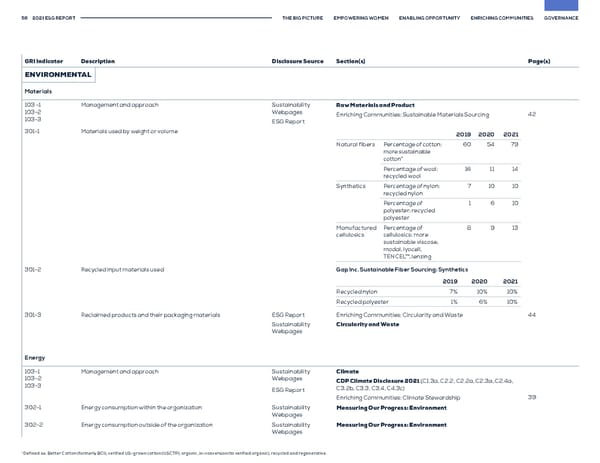58 2021 ESG REPORT THE BIG PICTURE EMPOWERING WOMEN ENABLING OPPORTUNITY ENRICHING COMMUNITIES GOVERNANCE GRI Indicator Description Disclosure Source Section(s) Page(s) ENVIRONMENTAL Materials 103 -1 Management and approach Sustainability Raw Materials and Product 103-2 Webpages Enriching Communities: Sustainable Materials Sourcing 42 103-3 ESG Report 301-1 Materials used by weight or volume 2019 2020 2021 Natural fibers Percentage of cotton: 60 54 79 more sustainable cotton* Percentage of wool: 16 11 14 recycled wool Synthetics Percentage of nylon: 7 10 10 recycled nylon Percentage of 1 6 10 polyester: recycled polyester Manufactured Percentage of 8 9 13 cellulosics cellulosics: more sustainable viscose, modal, lyocell, TENCEL™, lenzing 301-2 Recycled input materials used Gap Inc. Sustainable Fiber Sourcing: Synthetics 2019 2020 2021 Recycled nylon 7% 10% 10% Recycled polyester 1% 6% 10% 301-3 Reclaimed products and their packaging materials ESG Report Enriching Communities: Circularity and Waste 44 Sustainability Circularity and Waste Webpages Energy 103-1 Management and approach Sustainability Climate 103-2 Webpages CDP Climate Disclosure 2021 (C1.3a, C2.2, C2.2a, C2.3a, C2.4a, 103-3 ESG Report C3.2b, C3.3, C3.4, C4.3c) Enriching Communities: Climate Stewardship 39 302-1 Energy consumption within the organization Sustainability Measuring Our Progress: Environment Webpages 302-2 Energy consumption outside of the organization Sustainability Measuring Our Progress: Environment Webpages *Defined as: Better Cotton (formerly BCI), verified US-grown cotton (USCTP), organic, in-conversion (to verified organic), recycled and regenerative.
 GAP ESG Report Page 57 Page 59
GAP ESG Report Page 57 Page 59